The majority of my time in South America was spent in the wonderful country of Peru. I flew into Lima from Buenos Aires on 7th May. I left for Bolivia three weeks later.
My first impressions of the country weren't too promising. Lima is a pretty horrible place, even though I stayed in the relatively swanky seaside suburb of Mirafiores. The only good things about Lima were the main Plaza de Armas and the excellent gold museum. I also slipped a disc in my back in Lima - getting out of bed! - so my memories of the place aren't great!
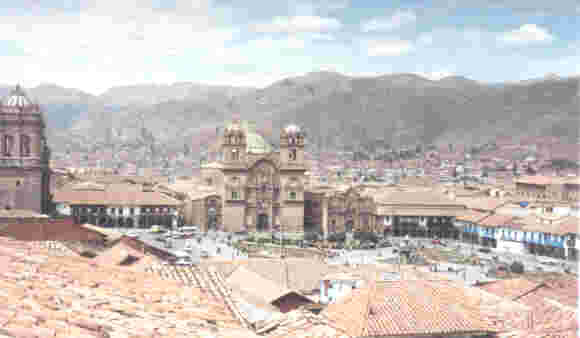 Lima was soon forgotten after the short flight
up into the Andes, arriving in Cusco (altitude about 3000m) early on a very
cold Sunday morning. Cusco is an excellent place. Not only is it crammed
with beautiful buildings of historical significance - the Spanish built
the colonial style city on top of the existing Inca foundations, so it's
a really interesting mix of cultures - but it's also a crossroads for travellers
of all ages and nationalities. The mix of foreigners and locals - both of
Spanish and Quechua descent - makes for a very colourful and vibrant city.
We spent four days in Cusco, just resting up and acclimatising to the thin
air at that altitude.
Lima was soon forgotten after the short flight
up into the Andes, arriving in Cusco (altitude about 3000m) early on a very
cold Sunday morning. Cusco is an excellent place. Not only is it crammed
with beautiful buildings of historical significance - the Spanish built
the colonial style city on top of the existing Inca foundations, so it's
a really interesting mix of cultures - but it's also a crossroads for travellers
of all ages and nationalities. The mix of foreigners and locals - both of
Spanish and Quechua descent - makes for a very colourful and vibrant city.
We spent four days in Cusco, just resting up and acclimatising to the thin
air at that altitude.
Another good thing about Cusco - it has both an English and an Irish pub in the main Plaza de Armas. If you saw the Michael Palin programme Full Circle, the guy who showed him round Peru, Barry Walker, was a friend of our trek leader Pablo, and he runs a pub in Cusco called the Cross Keys. I only met Barry the once, but it was still pretty difficult to keep me out of his pub during my brief stay in Cusco! The Irish pub, sadly, had no Guinness. I'm sure they tried to blame this on El Niño, since Peruvians blame everything else on the damned thing!
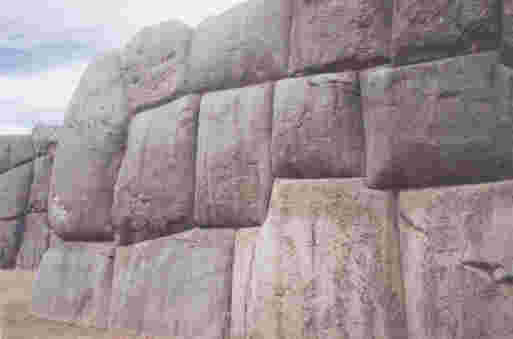 There are some
excellent Inca ruins just outside the city. The best are at a place called
Sacsayhuamán, where the Incas built a huge fort to protect Cusco
from the invading Spanish. The place is actually pronounced "sexy woman".
You'd think the tour guides would tire of cracking the same joke every day,
but their enthusiasm somehow remains unwavering. The walls are made of stones
over twice my height and weighing up to 300 tons, yet they're carved to
fit together exactly - there's no cement, and they've withstood invaders
and earthquakes for over 500 years - absolutely amazing.
There are some
excellent Inca ruins just outside the city. The best are at a place called
Sacsayhuamán, where the Incas built a huge fort to protect Cusco
from the invading Spanish. The place is actually pronounced "sexy woman".
You'd think the tour guides would tire of cracking the same joke every day,
but their enthusiasm somehow remains unwavering. The walls are made of stones
over twice my height and weighing up to 300 tons, yet they're carved to
fit together exactly - there's no cement, and they've withstood invaders
and earthquakes for over 500 years - absolutely amazing.
After Cusco we had a couple of days in the Sacred Valley of the Rio Urubamba. Here there are more Inca ruins on spectacular mountainside settings and also evidence of extensive terracing (agricultural, not football), even on the most extreme slopes. We also spent an afternoon at the significant ruins at Ollantaytambo, where we were 'treated' to a display of song and dance by some local schoolchildren, who then wouldn't let us leave Ollantaytambo until we'd crossed all of their palms with silver. The little tackers.
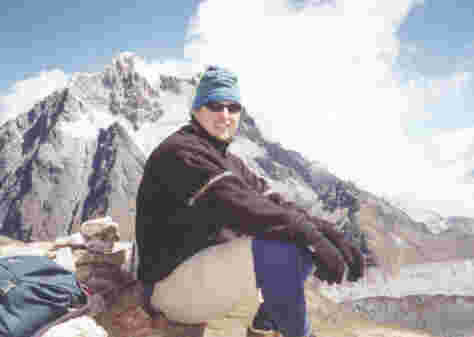 After the Sacred Valley we got down
to the business end of what we were really in Peru for - trekking. We drove
up a really rugged "road" (I use the word in its loosest sense)
into the mountains for a couple of hours to the trail head at a place called
Mollepata (3,400m above sea level). Here we met up with our muleskinners
- I don't know why they call them that, I mean they don't actually skin
the mules - loaded up and sent them on their way to the first night's campsite.
We followed some way behind, struggling with the heat and altitude and with
actually having to do some exercise for the first time on the trip.
I remember watching the 1970 World Cup in Mexico (showing my age now!) and
how soft I thought all the England players were for bleating about the altitude
problems in Guadalejara. Bobby, Mooro, Bally... I take it all back. Altitude
is a bitch! Even the simplest of things like breathing are difficult
at altitude, let alone trying to do any exercise. You're constantly dehydrated,
light-headed and your limbs feel like lead. On the plus side, alcohol has
greater effect at altitude, and the views from the top of the mountains
made it all worthwhile.
After the Sacred Valley we got down
to the business end of what we were really in Peru for - trekking. We drove
up a really rugged "road" (I use the word in its loosest sense)
into the mountains for a couple of hours to the trail head at a place called
Mollepata (3,400m above sea level). Here we met up with our muleskinners
- I don't know why they call them that, I mean they don't actually skin
the mules - loaded up and sent them on their way to the first night's campsite.
We followed some way behind, struggling with the heat and altitude and with
actually having to do some exercise for the first time on the trip.
I remember watching the 1970 World Cup in Mexico (showing my age now!) and
how soft I thought all the England players were for bleating about the altitude
problems in Guadalejara. Bobby, Mooro, Bally... I take it all back. Altitude
is a bitch! Even the simplest of things like breathing are difficult
at altitude, let alone trying to do any exercise. You're constantly dehydrated,
light-headed and your limbs feel like lead. On the plus side, alcohol has
greater effect at altitude, and the views from the top of the mountains
made it all worthwhile.
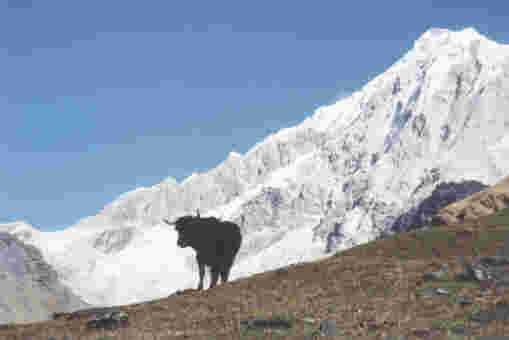 After two and a half days of trekking
up the slopes of Mt Salcantay (The Maker of the Skies, a particularly important
mountain to the Incas), we made it to the highest point of the trail - the
4820m pass at Incachiriasca (the place where the Inca catches a cold). I
never thought I'd make it, as the air got thinner and colder, but the sight
of the snow and glaciers kept me going 'til the top.
After two and a half days of trekking
up the slopes of Mt Salcantay (The Maker of the Skies, a particularly important
mountain to the Incas), we made it to the highest point of the trail - the
4820m pass at Incachiriasca (the place where the Inca catches a cold). I
never thought I'd make it, as the air got thinner and colder, but the sight
of the snow and glaciers kept me going 'til the top.
After all that exertion, we had a rest day and our muleskinners and cooks prepared a pachamanca - a traditional Peruvian barbie. They dig a big hole and make a fire in it, then they bury the fire along with a dead sheep and a shitload of potatoes and, one hour later, voila, you have a magnificent feast.
After the rest day we dropped down into the next valley and joined the main Inca Trail. At this stage we had to say goodbye to the muleskinners (hooved animals aren't allowed on the Inca Trail) and say hello to our team of porters, gaily attired in traditional Quechua. This wasn't so much a romantic notion as a practicality. The authorities in Machu Picchu National Park make the porters pay the US$17 entrance fee if they're not wearing national costume!
Joining the Inca Trail also meant meeting other human beings again. Even though this was the start of the trekking season, the Trail was really busy. This was a bit of a shock to the system after hardly seeing a soul for four days. On the plus side, the trail was now occasionally populated by enterprising local women selling cold beers by the bucketful.
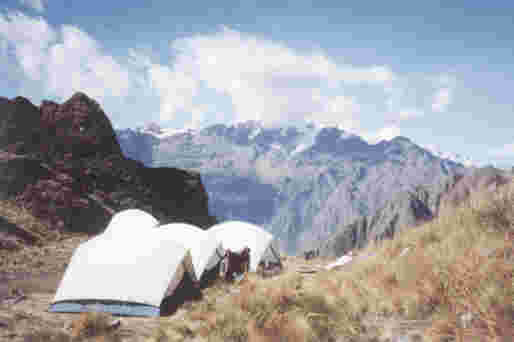 The Trail was a very pleasant mixture
of exposed high mountains and lower valleys with beautiful cloud forests.
Inca ruins were dotted about along the Trail and there was the occasional
llama, alpaca, American tourist or other dumb animal to keep us amused.
The Trail itself is a magnificent construction of well-preserved stone steps
for its entire 33km. The steps were a bit hard on the knees, however, and
the slipped disc in my back made itself known once more, now that my supply
of painkillers had run out. Again, the pain was forgotten as we were overwhelmed
by the sheer beauty of some of our camp sites: Sisaypampa, where we had
our pachamanca; Lulluchapampa, where I met a mad Kiwi girl running back
down the valley and out of the shadows, desperately trying to dry her underwear
(she had just washed it, before you start getting any ideas!) in the last
vanishing rays of the sun; the lakeside site at Cochapata and the stunning
site at Phuyupatamarca - the City in the Clouds - overlooking the Sun Gate
above Machu Picchu.
The Trail was a very pleasant mixture
of exposed high mountains and lower valleys with beautiful cloud forests.
Inca ruins were dotted about along the Trail and there was the occasional
llama, alpaca, American tourist or other dumb animal to keep us amused.
The Trail itself is a magnificent construction of well-preserved stone steps
for its entire 33km. The steps were a bit hard on the knees, however, and
the slipped disc in my back made itself known once more, now that my supply
of painkillers had run out. Again, the pain was forgotten as we were overwhelmed
by the sheer beauty of some of our camp sites: Sisaypampa, where we had
our pachamanca; Lulluchapampa, where I met a mad Kiwi girl running back
down the valley and out of the shadows, desperately trying to dry her underwear
(she had just washed it, before you start getting any ideas!) in the last
vanishing rays of the sun; the lakeside site at Cochapata and the stunning
site at Phuyupatamarca - the City in the Clouds - overlooking the Sun Gate
above Machu Picchu.
After four days on the Inca Trail we eventually reached a) a youth hostel selling beer and b) Intipunku - the Sun Gate. Pablo walked us up to the Sun Gate blindfolded and then said 'take a look at that!'. The first view of Machu Picchu from above was absolutely spectacular. From the Sun Gate you walk down into the ruins to get a closer look - and it's even better from close up. A lot of nonsense has been written about Machu Picchu, from sun worship to aliens, so I won't add to it, I'll just let the pictures do the talking...
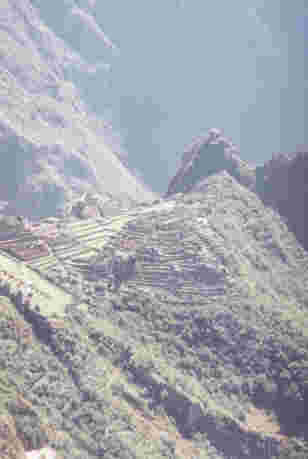
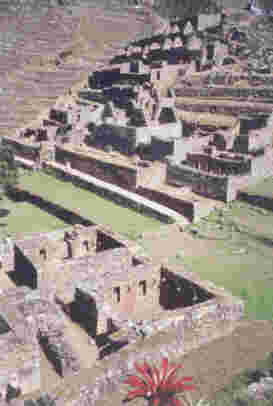

We finished the trek by walking down to the 'wild west' town of Aguas Calientes. It was sheer heaven jumping into the hot springs for which the town is famous. This was also the place where Pablo and I sat up playing dice with the barman of the local pub until 5am! They were selling Cusqueña in 1.1 litre bottles... excellent! Needless to say, I didn't make the 6am wake-up call for the professional guide round the ruins. I had to settle for the unaccompanied - unaccompanied except, that is, than by a massive hangover - midday tour. It was brilliant, nonetheless.
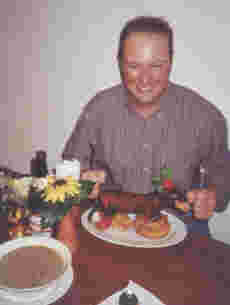 We got back to Cusco on the famous
tourist train - the one where it's so steep the train has to switchback
several times. It was very picturesque, travelling back up the Urubamba
Valley through some of the places we'd seen a week earlier, but not a great
way to spend a hangover. When we got back to Cusco, our group was splitting
up, so we went out for a celebration meal and enjoyed Cusco's local delicacy...
roast guinea pig! After the initial shock - they served it whole, standing
up on a plate with its feet in a Yorkshire pud, half a tomato on its head
and a carrot sticking out of its mouth - it was actually quite tasty!
We got back to Cusco on the famous
tourist train - the one where it's so steep the train has to switchback
several times. It was very picturesque, travelling back up the Urubamba
Valley through some of the places we'd seen a week earlier, but not a great
way to spend a hangover. When we got back to Cusco, our group was splitting
up, so we went out for a celebration meal and enjoyed Cusco's local delicacy...
roast guinea pig! After the initial shock - they served it whole, standing
up on a plate with its feet in a Yorkshire pud, half a tomato on its head
and a carrot sticking out of its mouth - it was actually quite tasty!
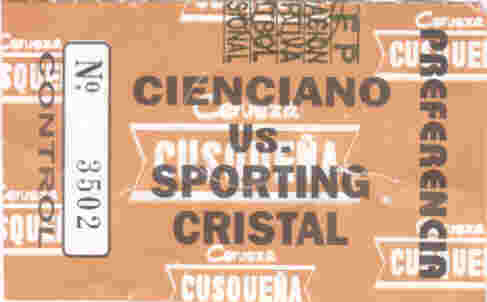 Also that day I went to
a Peruvian first division soccer match: Cienciano beat Sporting Cristal
Lima 2-1. I couldn't work out why there were so many riot police there -
maybe they knew there was an England fan in the crowd? In fact it turned
out that the police were there to protect the ref from the away team after
he'd allowed a pretty dubious goal on the stroke of half-time! Talking of
half-time, no pies or burgers here, just delicious beef hearts and potatoes
on skewers! The atmos at the game was excellent. Behind one goal was a sea
of red - Furia Roja - for Cienciano and behind the other the blue of Cristal,
and both sets of fans spent the whole game bouncing up and down (ala West
Brom) and playing drums and trumpets. Magnificent.
Also that day I went to
a Peruvian first division soccer match: Cienciano beat Sporting Cristal
Lima 2-1. I couldn't work out why there were so many riot police there -
maybe they knew there was an England fan in the crowd? In fact it turned
out that the police were there to protect the ref from the away team after
he'd allowed a pretty dubious goal on the stroke of half-time! Talking of
half-time, no pies or burgers here, just delicious beef hearts and potatoes
on skewers! The atmos at the game was excellent. Behind one goal was a sea
of red - Furia Roja - for Cienciano and behind the other the blue of Cristal,
and both sets of fans spent the whole game bouncing up and down (ala West
Brom) and playing drums and trumpets. Magnificent.
The next day we took the famous train ride across the Altiplano to Puno on the shores of Lake Titicaca. I don't know what was famous about it, other than it's ability to do serious damage to an already knackered back. Oh, I guess it was quite pleasant, and the vast flat plains made an interesting contrast to the Andes. But...
 The lake was excellent.
We went out onto the floating reed islands that are home to the Uros Indians.
They have reed houses, reed hotels and even a reed pub out on the islands.
We even went out on a reed boat and were invite to sample the local culinary
delight ... yep, you guessed it, reeds! On one of the islands they had a
hospital. The frightfully generous president had kindly donated an ambulance
to the islanders. Now these islands are on average about 200m x 200m, and
consist of a bed of reeds 1m thick - where are you going to use an ambulance?
Nice one Mr. Fujimore.
The lake was excellent.
We went out onto the floating reed islands that are home to the Uros Indians.
They have reed houses, reed hotels and even a reed pub out on the islands.
We even went out on a reed boat and were invite to sample the local culinary
delight ... yep, you guessed it, reeds! On one of the islands they had a
hospital. The frightfully generous president had kindly donated an ambulance
to the islanders. Now these islands are on average about 200m x 200m, and
consist of a bed of reeds 1m thick - where are you going to use an ambulance?
Nice one Mr. Fujimore.
After our time in Puno, we said our goodbyes to Pablo and drove across the border into Bolivia...